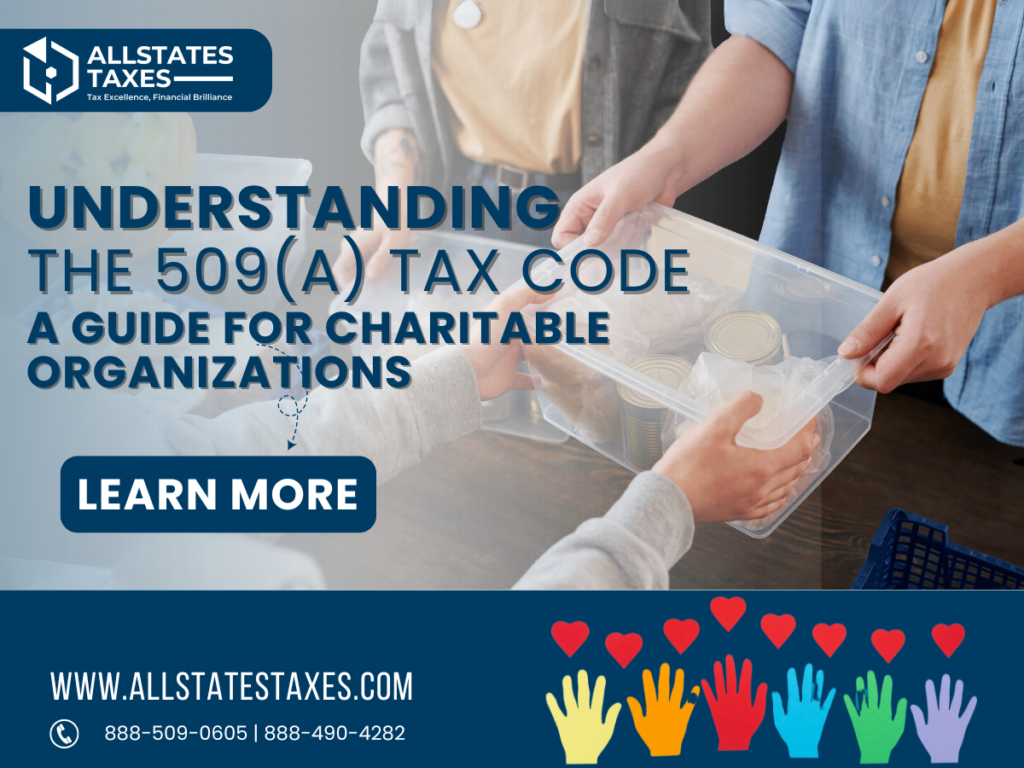The 509(a) tax code plays a critical role in how charitable organizations are classified under U.S. law. For many, understanding this tax provision is crucial for maintaining tax-exempt status, adhering to IRS regulations, and securing funding. But what exactly does this tax code entail, and why is it so important for nonprofits? This guide will walk you through the ins and outs of 509(a), exploring its subdivisions, benefits, and implications for public charities and private foundations.
What is the 509(a) Tax Code?
The 509(a) tax code is a subsection of the broader 501(c)(3) tax-exempt classification. It is used to determine whether an organization is a public charity or a private foundation. Initially, all 501(c)(3) organizations are considered private foundations by default. However, organizations can qualify as public charities by meeting specific requirements under section 509(a). This designation significantly impacts how these organizations operate, their funding sources, and their reporting obligations.
Public charities often benefit from less stringent regulations than private foundations. For example, they are allowed to receive contributions from a broader range of donors and can enjoy higher donation deductibility limits for their supporters. In contrast, private foundations face more stringent rules on how funds are distributed, including a mandatory payout requirement and restrictions on business holdings.
Key Differences Between 509(a) and 501(c)(3)
At its core, the 509(a) tax code is a further refinement of the well-known 501(c)(3) tax status. While all 509(a) organizations are 501(c)(3) entities, not all 501(c)(3) organizations are public charities under 509(a). Public charities generally have a broader base of financial support, including government grants and donations from the general public, rather than relying on a few individuals or entities for funding.
The tax treatment under 509(a) offers benefits for public charities by easing some of the compliance burdens placed on private foundations. Donors can deduct contributions to public charities more generously, making these organizations more attractive to potential benefactors.
Subdivisions of the 509(a) Tax Code
There are four main categories under the 509(a) tax code that define the type of public charity:
- 509(a)(1): This category applies to publicly supported charities that receive a significant portion of their funding from the public or governmental units. Typical examples include churches, schools, and hospitals. To qualify, these organizations must meet the public support test, which requires that at least one-third of their total support comes from public donations or government sources.
- 509(a)(2): Organizations that rely on earned income rather than donations fall into this category. These charities typically receive income from services related to their exempt purpose, such as museum ticket sales or membership fees. However, they must also meet a public support test, ensuring that no more than one-third of their funding comes from investment income.
- 509(a)(3): Known as supporting organizations, these entities exist to support other public charities. A supporting organization must pass three tests—organizational, operational, and relationship—to qualify under this section. They often serve as affiliates to larger institutions, such as universities or hospitals.
- 509(a)(4): This lesser-known category includes organizations dedicated to testing for public safety. For example, entities involved in fire prevention or motor vehicle safety testing might qualify under this provision.
Public Support Test: A Crucial Requirement
One of the most significant aspects of maintaining public charity status under 509(a) is passing the public support test. For both 509(a)(1) and 509(a)(2) organizations, this test requires that at least 33.3% of the organization’s funding comes from public sources, including individual donors, government grants, or program-related income. However, there’s a cap on contributions from any single source: no more than 2% of total support can come from any one donor without jeopardizing the charity’s public support status.
Failing to meet the public support requirement can result in the organization being reclassified as a private foundation, with all the additional regulations that come with this status. However, organizations that fall short of the threshold may still qualify by passing the “facts and circumstances” test, which evaluates a range of other factors to determine whether an organization truly operates as a public charity.
Private Foundations: The Alternative to Public Charity Status
If an organization cannot meet the criteria for 509(a) status, it is classified as a private foundation. Private foundations, like the Gates Foundation, generally derive funding from a single primary source, such as an individual, family, or corporation. These organizations are subject to stricter rules, including a 5% minimum annual distribution requirement and an excise tax on net investment income.
While private foundations have more control over their funds and mission, they also face greater restrictions. For example, they are prohibited from engaging in activities that might result in excessive business holdings or self-dealing, such as providing loans to foundation insiders.
The Benefits of 509(a) Status
For most nonprofits, qualifying as a public charity under 509(a) is highly advantageous. Public charities enjoy a wider base of support, less stringent regulatory oversight, and higher limits for tax-deductible donations. They are also exempt from the payout requirements and business holding restrictions imposed on private foundations.
In addition, 509(a) organizations are often better positioned to receive government grants and other forms of institutional support. This makes them more resilient and better able to serve their communities over the long term.
Conclusion
Understanding the 509(a) tax code is vital for any organization seeking to operate as a public charity in the United States. By securing 509(a) status, nonprofits can benefit from a more favorable regulatory environment, access a broader pool of donors, and ensure long-term sustainability. Whether you’re founding a new nonprofit or managing an existing organization, knowing how 509(a) impacts your tax-exempt status can make all the difference.
For organizations struggling to meet the public support requirements, the “facts and circumstances” test offers a second chance to maintain public charity status. Meanwhile, those that prefer the control and flexibility of a private foundation should be prepared for additional oversight and obligations.
FAQ
Q. What is the 509(a) tax code?
A. The 509(a) tax code classifies certain 501(c)(3) organizations as public charities or private foundations, based on their sources of funding and operational structure.
Q. How does an organization qualify for 509(a)(1) status?
A. To qualify for 509(a)(1) status, a public charity must receive at least one-third of its funding from the public or governmental units and pass a public support test.
Q. What is the difference between 509(a)(2) and 509(a)(3)?
A. A 509(a)(2) organization generates most of its income from activities related to its mission, such as fees for services. A 509(a)(3) organization, on the other hand, supports other public charities.
Q. What happens if a 509(a) organization fails the public support test?
A. If a 509(a) organization fails the public support test, it may be reclassified as a private foundation, which comes with stricter regulatory requirements.
Q. Are donations to 509(a) organizations tax-deductible?
A. Yes, donations to 509(a) organizations are generally tax-deductible, with limits depending on the donor’s income and the type of organization.
Q. What is the public support test?
A. The public support test ensures that at least 33.3% of an organization’s funding comes from the general public, ensuring its classification as a public charity under 509(a).



